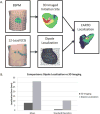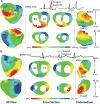Three-Dimensional Noninvasive Imaging of Ventricular Arrhythmias in Patients With Premature Ventricular Contractions
- PMID: 28976307
- PMCID: PMC6089378
- DOI: 10.1109/TBME.2017.2758369
Three-Dimensional Noninvasive Imaging of Ventricular Arrhythmias in Patients With Premature Ventricular Contractions
Abstract
Objective: Noninvasive imaging of cardiac electrical activity promises to provide important information regarding the underlying arrhythmic substrates for successful ablation intervention and further understanding of the mechanism of such lethal disease. The aim of this study is to evaluate the performance of a novel 3-D cardiac activation imaging technique to noninvasively localize and image origins of focal ventricular arrhythmias in patients undergoing radio frequency ablation.
Methods: Preprocedural ECG gated contrast enhanced cardiac CT images and body surface potential maps were collected from 13 patients within a week prior to the ablation. The electrical activation images were estimated over the 3-D myocardium using a cardiac electric sparse imaging technique, and compared with CARTO activation maps and the ablation sites in the same patients.
Results: Noninvasively-imaged activation sequences were consistent with the CARTO mapping results with an average correlation coefficient of 0.79, average relative error of 0.19, and average relative resolution error of 0.017. The imaged initiation sites of premature ventricular contractions (PVCs) were, on average, within 8 mm of the last successful ablation site and within 3 mm of the nearest ablation site.
Conclusion: The present results demonstrate the excellent performance of the 3-D cardiac activation imaging technique in imaging the activation sequence associated with PVC, and localizing the initial sites of focal ventricular arrhythmias in patients. These promising results suggest that the 3-D cardiac activation imaging technique may become a useful tool for aiding clinical diagnosis and management of ventricular arrhythmias.
Figures





Similar articles
-
Noninvasive cardiac activation imaging of ventricular arrhythmias during drug-induced QT prolongation in the rabbit heart.Heart Rhythm. 2013 Oct;10(10):1509-15. doi: 10.1016/j.hrthm.2013.06.010. Epub 2013 Jun 14. Heart Rhythm. 2013. PMID: 23773986 Free PMC article.
-
Noninvasive imaging of three-dimensional cardiac activation sequence during pacing and ventricular tachycardia.Heart Rhythm. 2011 Aug;8(8):1266-72. doi: 10.1016/j.hrthm.2011.03.014. Epub 2011 Mar 10. Heart Rhythm. 2011. PMID: 21397046 Free PMC article.
-
Clinical impact of a novel three-dimensional electrocardiographic imaging for non-invasive mapping of ventricular arrhythmias-a prospective randomized trial.Europace. 2015 Apr;17(4):591-7. doi: 10.1093/europace/euu282. Epub 2014 Oct 27. Europace. 2015. PMID: 25349226 Clinical Trial.
-
Ablation of premature ventricular complexes exclusively guided by three-dimensional noninvasive mapping.Card Electrophysiol Clin. 2015 Mar;7(1):109-15. doi: 10.1016/j.ccep.2014.11.010. Epub 2014 Dec 12. Card Electrophysiol Clin. 2015. PMID: 25784027 Review.
-
Evaluation and Management of Premature Ventricular Complexes.Circulation. 2020 Apr 28;141(17):1404-1418. doi: 10.1161/CIRCULATIONAHA.119.042434. Epub 2020 Apr 27. Circulation. 2020. PMID: 32339046 Review.
Cited by
-
A two-step inverse solution for a single dipole cardiac source.Front Physiol. 2023 Sep 7;14:1264690. doi: 10.3389/fphys.2023.1264690. eCollection 2023. Front Physiol. 2023. PMID: 37745249 Free PMC article.
-
Systematic review of computational techniques, dataset utilization, and feature extraction in electrocardiographic imaging.Med Biol Eng Comput. 2025 May;63(5):1289-1317. doi: 10.1007/s11517-024-03264-z. Epub 2025 Jan 9. Med Biol Eng Comput. 2025. PMID: 39779645
-
Fusion Imaging of Non-Invasive and Invasive Cardiac Electroanatomic Mapping in Patients with Ventricular Ectopic Beats: A Feasibility Analysis in a Case Series.Diagnostics (Basel). 2024 Mar 15;14(6):622. doi: 10.3390/diagnostics14060622. Diagnostics (Basel). 2024. PMID: 38535042 Free PMC article.
-
Electrocardiographic imaging for cardiac arrhythmias and resynchronization therapy.Europace. 2020 Aug 5;22(10):1447-62. doi: 10.1093/europace/euaa165. Online ahead of print. Europace. 2020. PMID: 32754737 Free PMC article.
-
Activation recovery interval imaging of premature ventricular contraction.PLoS One. 2018 Jun 15;13(6):e0196916. doi: 10.1371/journal.pone.0196916. eCollection 2018. PLoS One. 2018. PMID: 29906289 Free PMC article. Clinical Trial.
References
-
- Mozaffarian D, et al. Heart Disease and Stroke Statistics—2015 Update A Report From the American Heart Association. Circulation. 2015 Jan;131(4):e29–e322. - PubMed
-
- Oster J, Behar J, Sayadi O, Nemati S, Johnson AEW, Clifford GD. Semisupervised ECG Ventricular Beat Classification With Novelty Detection Based on Switching Kalman Filters. IEEE Trans Biomed Eng. 2015 Sep;62(9):2125–2134. - PubMed
-
- Nademanee K, et al. Prevention of Ventricular Fibrillation Episodes in Brugada Syndrome by Catheter Ablation Over the Anterior Right Ventricular Outflow Tract Epicardium. Circulation. 2011 Mar;123(12):1270–1279. - PubMed
-
- Yamada T, Maddox WR, McElderry HT, Doppalapudi H, Plumb VJ, Kay GN. Radiofrequency catheter ablation of idiopathic ventricular arrhythmias originating from intramural foci in the left ventricular outflow tract: efficacy of sequential versus simultaneous unipolar catheter ablation. Circ Arrhythm Electrophysiol. 2015 Apr;8(2):344–352. - PubMed
Publication types
MeSH terms
Grants and funding
LinkOut - more resources
Full Text Sources
Other Literature Sources

